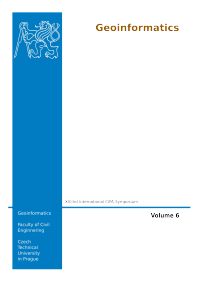Image Based Modeling from Spherical Photogrammetry and Structure for Motion. The Case of the Treasury, Nabatean Architecture in Petra
DOI:
https://doi.org/10.14311/gi.6.9Keywords:
spherical photogrammetry, structure for motion, image based modeling, cultural heritage 3D documentationAbstract
This research deals with an efficient and low cost methodology to obtain a metric and photorealstic survey of a complex architecture. Photomodeling is an already tested interactive approach to produce a detailed and quick 3D model reconstruction. Photomodeling goes along with the creation of a rough surface over which oriented images can be back-projected in real time. Lastly the model can be enhanced checking the coincidence between the surface and the projected texture. The challenge of this research is to combine the advantages of two technologies already set up and used in many projects: spherical photogrammetry (Fangi, 2007,2008,2009,2010) and structure for motion (Photosynth web service and Bundler + CMVS2 + PMVS2). The input images are taken from the same points of view to form the set of panoramic photos paying attention to use well-suited projections: equirectangular for spherical photogrammetry and rectilinear for Photosynth web service. The performance of the spherical photogrammetry is already known in terms of its metric accuracy and acquisition quickness but time is required in the restitution step because of the manual homologous point recognition from different panoramas. In Photosynth instead the restitution is quick and automated: the provided point clouds are useful benchmarks to start with the model reconstruction even if lacking in details and scale. The proposed workflow needs of ad-hoc tools to capture high resolution rectilinear panoramic images and visualize Photosynth point clouds and orientation camera parameters. All of them are developed in VVVV programming environment. 3DStudio Max environment is then chosen because of its performance in terms of interactive modeling, UV mapping parameters handling and real time visualization of projected texture on the model surface. Experimental results show how is possible to obtain a 3D photorealistic model using the scale of the spherical photogrammetry restitution to orient web provided point clouds. Moreover the proposed research highlights how is possible to speed up the model reconstruction without losing metric and photometric accuracy. In the same time, using the same panorama dataset, it picks out a useful chance to compare the orientations coming from the two mentioned technologies (Spherical Photogrammetry and Structure for Motion).References
E.d'Annibale, G.Fangi (2009) – Interactive modelling by projection of oriented spherical panorama – 3D-Arc'2009,
irtual Reconstruction and Visualisation of complex Architectures – Trento 25-29 February 2009- ISPRS Archives
l XXXVIII-5/W1 : 1682-1777 on cd.
E.d'Annibale, S.Massa, G.Fangi (2010) - Photomodeling and point clouds from spherical panorama - Nabatean
itecture in Petra, Jordan - C.I.P.A. Workshop, Petra 4-8 November 2010.
G.Fangi (2006) - Investigation On The Suitability Of The Spherical Panoramas By Realviz Stitcher For Metric
oses, ISPRS Archive vol.XXXVI Part 5, Dresden 25-27 September 2006.
G.Fangi- Una nuova fotogrammetria architettonica con i panorami sferici multimmagine – Sifet Symposium,
zo 27-29 Giugno 2007, CD.
G.Fangi – The Multi-image spherical Panoramas as a tool for Architectural Survey - XXI International CIPA
osium, 1-6 October 2007, Atene, ISPRS International Archive – vol. XXXVI-5/C53 – ISSN 1682-1750 – CIPA
ives vol. XXI – 2007, ISSN 0256-1840 - pg.311-316.
G.Fangi – La Fotogrammetria sferica dei mosaici di scena per il rilievo architettonico – bollettino SIFET n. 3 2007
-42.
G.Fangi, P.Clini, F.Fiori – Simple and quick digital technique for the safeguard of Cultural Heritage. The Rustem
a mosque in Istanbul – DMACH 4 - 2008 - Digital Media and its Applications in Cultural Heritage 5 - 6
mber, 2008, Amman pp 209-217.
G.Fangi (2009) – Further Developments of the Spherical Photogrammetry for Cultural Heritage – XXII Cipa
osium, Kyoto, 11-15 Ottobre 2009.
Richard Hartley and Andrew Zisserman (2003).Multiple View Geometry in Computer Vision, . Cambridge
University Press. ISBN 0-521-54051-8.
Noah Snavely, Steven M. Seitz, Richard Szeliski (2006). Photo Tourism: Exploring image collections in 3D.ACM
actions on Graphics (Proceedings of SIGGRAPH 2006).
Noah Snavely, Steven M. Seitz, Richard Szeliski, (2007). Modeling the World from Internet Photo Collections.
national Journal of Computer Vision.
L.Barazzetti, G.Fangi, F.Remondino, M.Scaioni, (2010) Automation in Multi-Image Spherical Photogrammetry for
chitectural Reconstructions - The 11th International Symposium on Virtual Reality, Archaeology and Cultural
age VAST (2010) A. Artusi, M. Joly-Parvex, G. Lucet, A. Ribes, and D. Pitzalis (Editors).
E.d'Annibale (2010) – New VR system for navigation and documentation of Cultural Heritage – C.I.P.A.
Workshop, Petra 4-8 November 2010.
MeshLab http://meshlab.sourceforge.net/
Photosynth http://www.photosynth.net
SynthExport http://synthexport.codeplex.com/
SFM toolkit http://www.visual-experiments.com/demos/sfmtoolkit/
SIFT GPU http://www.cs.unc.edu/~ccwu/siftgpu/
Bundler http://phototour.cs.washington.edu/bundler/
Downloads
Published
Issue
Section
License
- Authors retain copyright and grant the journal right of first publication with the work simultaneously licensed under a Creative Commons Attribution License that allows others to share the work with an acknowledgement of the work's authorship and initial publication in this journal.
- Authors are able to enter into separate, additional contractual arrangements for the non-exclusive distribution of the journal's published version of the work (e.g., post it to an institutional repository or publish it in a book), with an acknowledgement of its initial publication in this journal.
- Authors are permitted and encouraged to post their work online (e.g., in institutional repositories or on their website) prior to and during the submission process, as it can lead to productive exchanges, as well as earlier and greater citation of published work (See The Effect of Open Access).

